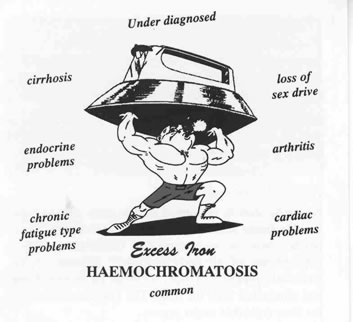|
Hemochromatosis and Diabetes

Hemochromatosis is a disorder which is more commonly inherited. The body absorbs and then will store amounts of iron that are too high. This disorder and diabetes seem to be related with each other. What is the association between hemochromatosis and diabetes? This link was first recognized somewhere back in the 1800's when doctors found the medical term, bronze diabetes. They called it broze diabetes due to the changes that took place in the skin pigment that this iron disorder causes in people. One study suggested that the relation to diabetes was damage to the pancreas from the iron deposits. In genetic linking, it is associated the C282Y incidence, which is a mutation of the HFE gene, higher in type 2 diabetics. Though people can have defective hemochromatosis genes, the symptoms don't usually happen until much later in adulthood. The signs that are shown with this problem are joint pain, fatigue, abdominal pain, heart problems, and loss of a sexual drive. On the other hand, there might also be no appearance of any symptoms. This iron disorder can be diagnosed based on your bloodwork. One of the tests is called the transferrin saturation test. This test determines how much iron is inside the protein that carries your iron to the blood. Another test which is the serum ferritin test will show iron levels in your liver. If these blood tests show higher than normal levels of iron, then a test called HFE mutation which is a special test, will be given to diagnose the problem for sure. In order to help the body rid itself of excess iron then, treatments will be with something called phlebotomy, in other words blood removal. These methods are safe and also a simple procedure. The earlier you know you have this disorder, the better. This way it cannot do much damage to the organs. So having diabetes, long-term tiredness, joint diseases, elevated liver enzymes, or heart disease, should be tested for this disorder on a regular basis.
|





